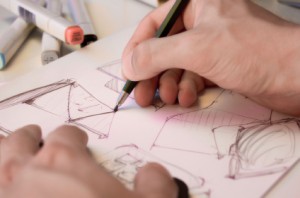 Designing a product can be a daunting task, especially if your product needs to stand out in an already crowded niche. I often talk to some aspiring entrepreneurs who have no idea where to begin or have horror stories for the services they received. Below I document 6 tips that virtually any entrepreneur can use when outsourcing a product design project – regardless of their budget.
Designing a product can be a daunting task, especially if your product needs to stand out in an already crowded niche. I often talk to some aspiring entrepreneurs who have no idea where to begin or have horror stories for the services they received. Below I document 6 tips that virtually any entrepreneur can use when outsourcing a product design project – regardless of their budget.
1. Identify What Makes Your Product Different
One of the first concepts most entrepreneurs do not address is a clear presentation of what makes their product different. This need not be super convoluted, but rather one can typically sum up their idea in a few sentences – one sentence is even better. Whenever contemplating a new product idea, I always think through the following. To start, you need to be able to clearly define your product’s core benefit. If you cannot convey your product’s benefit, then how can the consumer? Please, don’t read on if you do not have an answer to this first step. It’s that important!
2. Do Your Homework
Now that you’ve decided what sets your product apart from your competition, go out and do your homework on other successful designs. Try starting with plain and simple research, by going and checking out other products that have been successful. If nothing else, it will surely save you (and likely a designer) tons of time. Because think about it, you’ll already have a laundry list of products that may help you flesh out the design of your product.
There’s a vast array of resources online with which you can view quality products. For example, sites like TheDieline LovelyPackaging are always featuring stunning product designs from top notch designers and students across the globe. Other sites like SmashingMagazine & PSDTuts are some other fantastic – and often inspirational – resources.
3. Take Advantage Of Croudsourcing
In short, crowdsourcing is a recent popular trend that allows entrepreneurs to source tasks and projects through the crowd, instead of individually. The main advantage of crowdsourcing is that it can provide you with multiple people to work on your task, which will lead to quicker innovation. Having other people communicating, critiquing, and innovate on your product concept is a great way to get real time feedback on your idea and the general direction of your concept.
Two popular online resources I use are 99 designs and Amazon’sMechanicalTurk. 99 designs is one of the most popular crowdsourcing sites online. It allows you to easily have 20+ designers working on your project. In addition, I also use Amazon’s Mechanical Turk to get random feedback on my product. For just $10, I can oftentimes get insight from over 100 people on my product using Mechanical Turk.
4. Use More Traditional Marketplaces
A popular place to start in sourcing designers is to search your local Craigslist market. I often take it one step further and search all of Craigslist, by using AllOfCraigs. When doing this, be sure to use very specific keywords (e.g., consumer packaged goods designer). Other popular sites like oDesk & Elance will put you in contact with thousands of freelance workers all over the globe.
If you’re on an extremely tight budget consider using sites such as Fiverr, Tenbuxx, and Gigbuxx to cheaply find solutions. Fiverr is a great site, which I use all the time. More often than not, it’s a place where experts pitch their services for only $5. You would be shocked at what you can find on Fiverr. Besides design work, I’ve also been able to find solutions for keyword research, copywriting, and even an aromatherapy consultant!
5. Try Non-Marketplaces
I’ve found that the best designers are not even competing for jobs online at all. Websites such as Behance showcase outstanding designer portfolios, but are not a marketplace to sell that designer’s services. Since this is not a marketplace, keep in mind that not all designers featured are freelancing, or even interested in becoming a freelancer on your project. The best approach is to identify 10-15 designers and send them individual messages inquiring about their freelance services.
Please note: Do NOT send these designers a run-of-the-mill, generic email! Remember, these are some of the best designers in the world, and oftentimes they are turning down more projects than they accept. So please, take some time to study their portfolio so you can personally pitch them on what elements you like in their style and why they should take on your project.
6. Use Effective Tools
There are a lot of different tools and apps you can use to manage freelancers, but the two FREE tools I use the most are Skype & Jing. Most people are familiar with Skype, but many are unaware of it’s robust functionality. One powerful feature, for example, allows users to share their screens with each other. Most freelancers use and understand Skype, so I strongly recommend that you use it in order to have a brief conversation before hiring any contractor.
Another powerful tool is JING, which allows you to quickly record your screen in 5 min or less and then upload that recording to the web. Once uploaded to the web, JING videos are extremely easy to share. I use JING everyday. It’s such an easy way to quickly take screenshots & screencasts. Moreover, not only is JING free, but it is also readily available on Windows and Mac.
Will Evans is the founder of Chiefs Energizing Face Wash, a face wash that wakes men up. He can be contacted on twitter @evans_will.




